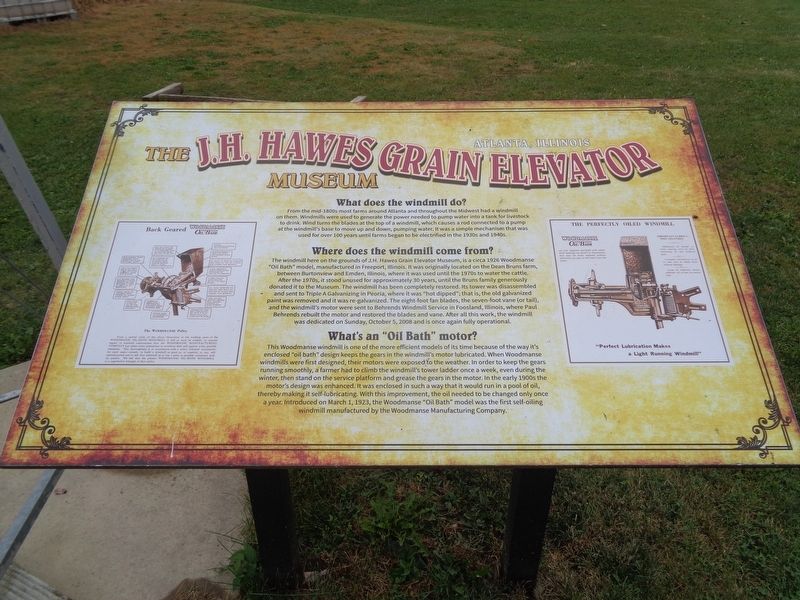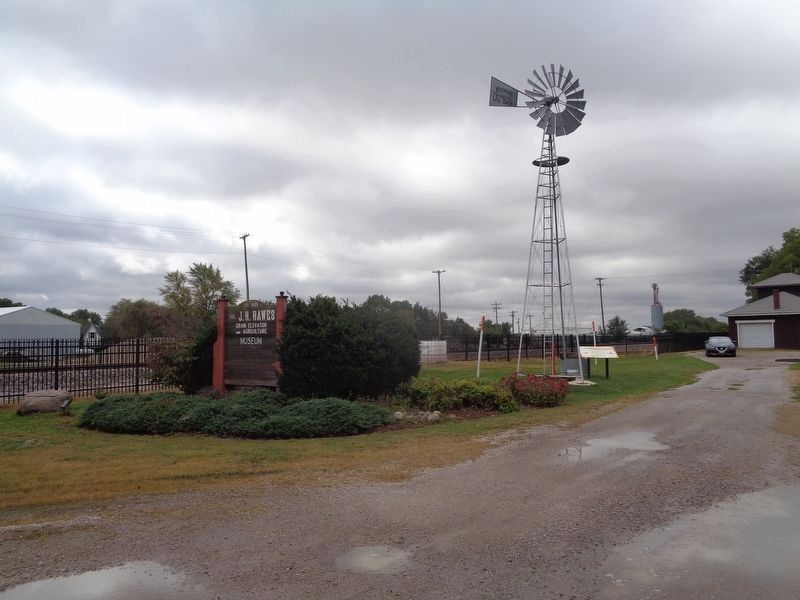Atlanta in Logan County, Illinois — The American Midwest (Great Lakes)
The J.H. Hawes Grain Elevator Museum
Atlanta, Illinois
What does the windmill do?
From the mid-1800s most farms around Atlanta and throughout the Midwest had a windmill on them. Windmills were used to generate the power needed to pump water into a tank for livestock to drink. Wind turns the blades at the top of a windmill, which causes a rod connected to a pump at the windmill's base to move up and down, pumping water. It was a simple mechanism that was used for over 100 years until farms began to be electrified in the 1930s and 1940s.
Where does the windmill come from?
The windmill here on the grounds of J.H. Hawes Grain Elevator Museum, is a circa 1926 Woodmanse "Oil Bath" model, manufactured in Freeport, Illinois. It was originally located on the Dean Bruns farm, between Burtonview and Emden, Illinois, where it was used until the 1970s to water the cattle. After the 1970s, it stood unused for approximately 30 years, until the Bruns family generously donated it to the Museum. The windmill has been completely restored. Its tower was disassembled and sent to Triple A Galvanizing in Peoria, where it was "hot dipped"; that is, the old galvanized paint was removed and it was re-galvanized. The eight-foot fan blades, the seven-foot vane (or tail), and the windmill's motor were sent to Behrends Windmill Service in Foosland, Illinois, where Paul Behrends rebuilt the motor and restored the blades and vane. After all this work, the windmill was dedicated on Sunday, October 5, 2008 and is once again fully operational.
What's an "Oil Bath" motor?
This Woodmanse windmill is one of the more efficient models of its time because of the way it's enclosed "oil bath" design keeps the gears in the windmill's motor lubricated. When Woodmanse windmills were first designed, their motors were exposed to the weather. In order to keep the gears running smoothly, a farm had to climb the windmill's tower ladder once a week, even during the winter, then stand on the service platform and grease the gears in the motor. In the early 1900s the motor's design was enhanced. It was enclosed in such a way that it would run in a pool of oil, thereby making it self-lubricating. With this improvement, the oil needed to be changed only once a year. Introduced on March 1, 1923, the Woodmanse "Oil Bath" model was the first self-oiling windmill manufactured by the Woodmanse Manufacturing Company.
Erected by J.B. Hawes Grain Elevator Museum.
Topics. This historical marker is listed in these topic lists: Agriculture • Industry & Commerce.
Location. 40° 15.636′ N, 89° 14.019′ W. Marker
is in Atlanta, Illinois, in Logan County. Marker is on 1st Street south of NW Arch Street, on the left when traveling south. Touch for map. Marker is at or near this postal address: 105-211 1st St, Atlanta IL 61723, United States of America. Touch for directions.
Other nearby markers. At least 8 other markers are within walking distance of this marker. J.H. Hawes Grain Elevator (a few steps from this marker); Scale House #2 (a few steps from this marker); Welcome #1 (a few steps from this marker); Engine House #5 (within shouting distance of this marker); Box Car #6 (within shouting distance of this marker); Atlanta Public Library-Museum (about 400 feet away, measured in a direct line); Bushnell Grist Mill (about 400 feet away); Library Clock Tower (about 400 feet away). Touch for a list and map of all markers in Atlanta.
Also see . . . J.H. Hawes Elevator on Wikipedia. Added to the National Register of Historic Places (#91000571) in 1991, it is the only restored wooden grain elevator in Illinois on the NRHP. (Submitted on December 14, 2020, by Jason Voigt of Glen Carbon, Illinois.)
Credits. This page was last revised on December 14, 2020. It was originally submitted on December 14, 2020, by Jason Voigt of Glen Carbon, Illinois. This page has been viewed 110 times since then and 6 times this year. Photos: 1, 2. submitted on December 14, 2020, by Jason Voigt of Glen Carbon, Illinois.

